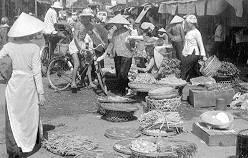|
VIETNAMESE FOOD |
| Some Vietnamese claim that their civilization is a spiritual culture
as opposed to the material culture of the West. This may be! However,
their practical sense and the gifts of tropical climate and geography
allow them to enjoy the earthly pleasure of an abundant variety of foods
also. For rich or poor, most South Vietnamese have enough to eat, and,
under peaceful conditions, their diet could be fairly adequate and
varied.
Most of the Vietnamese who live in the large towns and cities eat at least three times a day. An adult may eat as much as a kilo (2-1/5 lb.) of rice per day as a basic food. Rice, in some form, is normally found at all three meals when foreign aid foods are not utilized. Although foods vary according to season and economic class, standard items of food for a Vietnamese businessman include rice, fried shrimp, fish or vegetable soup, scented leaves (rau song), bean sprouts (gia) and fish stewed in a fish sauce (nuoc-mam), red pepper, or shredded banana stalk mixed with scented leaves and cucumber can be obtained most of the time. The most popular vegetables among all classes of Vietnamese are the germinated bean sprouts (gia), and the vinelike vegetable which grows in rivers and waterways called bindweed (rau muong). Both are reasonably priced and may be eaten raw or cooked by the Vietnamese, but until an American's resistance is high, the cooked may leave him in a happier state of health. Along the coast and delta, fruit also forms an important part of the diet. Pineapples, watermelons, oranges, tangerines, bananas, mangoes, and mangosteens seem to be on the market most of the year. The poor man of the large towns and cities does not fare quite so well in spite of the so-called "luxury of city living." since the average family of six has no more than about 70 cents a day for food, the housewife's problem in not variety and quality, but quantity! At home the laborer's food, in addition to rice, consists of bindweed, shrimp, pork fat, hard-boiled duck eggs seasoned in nuoc-mam. The amounts of the above items are quite small since they are used basically as condiments, and not as Americans use meats or vegetables.
As one climbs to higher economic levels, the diet tends to become richer, so perhaps the day will come when the Vietnamese will have their percentage of heart attacks also. The wealthy seem to enjoy a species of rice called "fox fangs" (nang chon) and prefer their fish sauce to be from Phu-Quoc Island or Phan Thiet. Other delicacies include swallow's nests, octopus, half-hatched eggs, abalone, shark's fin, etc. Incidentally, gathering and exporting swallow's nests in South Vietnam is government controlled in order to maintain the quality of the product as well as to preserve this unique industry of some of the off-shore islands. Perhaps the day is not far off when the Vietnamese can fully enjoy their abundant variety of foodstuffs without restrictions and insufficiencies which are the consequences of war. Courtesy of the 1967 USMC Unit Leaders Personal Response Handbook
|
 While at work in the cities and towns, the laborer can buy food from
a "sidewalk mobile Howard Johnson." For about a dime he can
get a good-sized bowl of rice, some fried omelet, a bit of fried fish or
shrimp, perhaps some duramam (preserved cucumber), and a bowl of
hot tea to settle the meal. Should a between-meal pickup be needed, and
funds available, bowls of soup can be purchased from women "Hot
Shoppe" attendants who move their businesses around town balanced
on their shoulders. Among the favorite soups are a rice soup with hog
intestines, liver, stomach, etc., and rice noodles with a clear meat
consomme.
While at work in the cities and towns, the laborer can buy food from
a "sidewalk mobile Howard Johnson." For about a dime he can
get a good-sized bowl of rice, some fried omelet, a bit of fried fish or
shrimp, perhaps some duramam (preserved cucumber), and a bowl of
hot tea to settle the meal. Should a between-meal pickup be needed, and
funds available, bowls of soup can be purchased from women "Hot
Shoppe" attendants who move their businesses around town balanced
on their shoulders. Among the favorite soups are a rice soup with hog
intestines, liver, stomach, etc., and rice noodles with a clear meat
consomme.